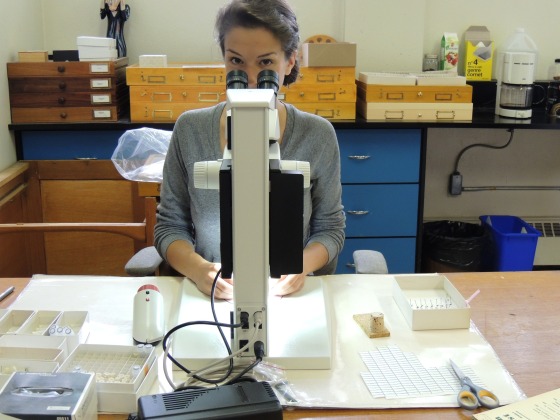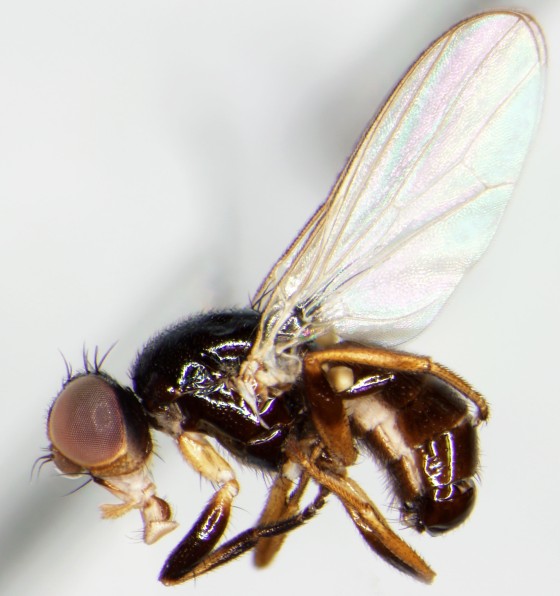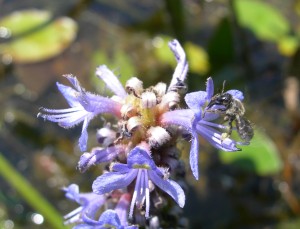By Sabrina Rochefort, MSc student, McGill University.
Early in my undergraduate program at McGill University, I was looking for an opportunity to volunteer in a lab, where I could feed my need to learn and make new discoveries. That led me to Terry Wheeler’s lab; he was the teacher for my evolution class at that time.
I had a strong interest in evolution and paleontology, and was hoping to pursue that field. But Terry informed me that volunteering in his lab did not involve studying fossils, but instead studying tiny insects. Curious and willing to learn about insects, I decided to give it a try! At the Lyman Museum, I quickly discovered that entomology is a field of study with great opportunities and with an infinite number of projects. Besides studying for my degree, and working on weekends at Tim Hortons, I was volunteering up to 12 hours a week, between and after classes, pinning flies and identifying them. I couldn’t lie to myself anymore, I had developed a strong passion for entomology!
Volunteering gradually transformed into a student job. It’s then that Terry introduced me to the fly family Piophilidae, commonly known as the Skipper Flies. I spent numerous hours familiarising myself with piophilids, reading literature, learning to identify them, their ecology, etc. All that knowledge that I acquired in entomology during my undergraduate studies gave me a great opportunity: the chance to pursue graduate studies. I am presently undertaking a Master’s project on the taxonomy and phylogeny of Piophilidae.
Now, let’s put a little less attention on my background and a little more on this wonderful family of flies and my project!
Piophilids are small to medium flies (3 to 9mm), which are abundant and diverse, especially in the northern hemisphere. To date, there are 82 described species worldwide. They mainly feed and reproduce on decaying organic matter. This family is of interest in several scientific domains such as forensic entomology (for their presence on carrion), in behavior (for their unique sexual selection strategies) and in biodiversity (for their interesting geographic distribution in the arctic). Several species are also pests in the food industry. The study of their taxonomy and phylogeny is essential for several reasons: to be able to identify specimens found in studies; to document the geographic distribution of species; to establish their phylogenetic relationships; and to learn more about their biology and ecology. The main objectives of my thesis are a taxonomic revision of the Nearctic Piophilidae and phylogenetic analysis of the genera worldwide.
A statement that is often repeated in our lab is that it is important for taxonomists and ecologists to collaborate, and that the outcomes of our taxonomic projects should be useful not only for taxonomists but also to other entomologists in other fields of expertise. And that is right! For taxonomy to make sense, it is essential that other researchers be able to understand it and use our work. This can be done by providing them with “working tools” such as identification keys which are simple and adapted to a specific need. It is for that reason that, as a side project to my thesis, I decided to collaborate with Marjolaine Giroux, from the Montreal Insectarium, Jade Savage from Bishop’s University and my supervisor Terry Wheeler on a publication and key to the Piophilidae species that may be found in forensic entomology studies in North America. That paper has just been published in the Canadian Journal of Arthropod identification. We reviewed some of the problems associated with identification of piophilids, and the need to develop a user-friendly key to the species. We wanted to create a key with lots of photographs, that was user-friendly and simple for non-specialists, and that would be published on-line and open access. Because of this, CJAI was the ideal journal for our paper.
Seeing this publication completed early in my graduate studies is a great accomplishment for me. It gave me the opportunity to share my knowledge and make taxonomy more accessible to students, amateur entomologists and researchers in the academic and scientific community. Undertaking a project in a less familiar field which is linked to your expertise is a very gratifying experience which I strongly encourage other students to try. From this experience, I acquired new skills and knowledge, I made connections with researchers in other fields of study and I was able to make more connections between my Master’s thesis and other subjects in entomology.
Reference
Rochefort, S., Giroux, M., Savage, J., Wheeler, T.A. 2015. Key to Forensically Important Piophilidae (Diptera) in the Nearctic Region. Canadian Journal of Arthropod Identification No. 27: January 22, 2015. Available online









